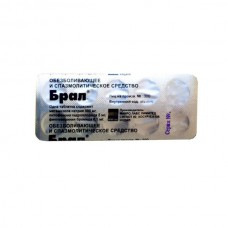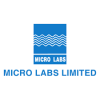Expiration date: 09/2026
International name: Metamizole sodium+Pitofenone+Fenpiverinium bromide
Group affiliation: non-narcotic Analgesic (non-narcotic analgesic+antispasmodic)
Description of the active substance (INN): Metamizole sodium+Pitofenone+Fenpiverinia bromide
Dosage form:
solution for intravenous and intramuscular injection, tablets
Pharmacological action:
Combined analgesic and antispasmodic, the combination of components of a preparation leads to mutual strengthening of their pharmacological action. Metamizole sodium is a derivative of pirazolona, has analgesic and antipyretic effect. Pitofenone hydrochloride has a direct myotropic effect on smooth muscles (papaverinopodobnoe action). Fenpiverinia bromide has a m-holinoblokirutm effect and provides additional myotropic effect on smooth muscles.
Indications:
Pain syndrome (weak to moderate) spasms of smooth muscles of internal organs renal colic, spasm of the ureter and bladder biliary colic, intestinal colic, biliary dyskinesia, postcholecystectomical syndrome, chronic colitis algomenorrhea, diseases of the pelvic organs. For short-term therapy: arthralgia, myalgia, neuralgia, sciatica. As a subsidiary of LS: pain syndrome after surgical interventions and diagnostic procedures.
Contraindications:
Hypersensitivity (including to pyrazolone derivative), oppression of bone marrow hematopoiesis, severe hepatic and/or renal failure, deficiency of glucose-6-phosphate dehydrogenase, tachyarrhythmias, severe angina, decompensated CHF, angle-closure glaucoma, prostatic hyperplasia (with clinical manifestations), intestinal obstruction, megacolon, collapse, pregnancy (especially in I trimester and in recent 6 ned), lactation. For/in the introduction - infancy (up to 3 months) or body weight less than 5 kg. For tablets - children's age (up to 5 years).C caution. Renal/hepatic failure, bronchial asthma, "aspirin" triad, a tendency to arterial hypotension, hypersensitivity to other NSAIDs.
Side effects:
Allergic reactions: urticaria (including the conjunctiva and mucous membranes of the nose and throat), angioedema, in rare cases - malignant exudative erythema (Stevens-Johnson syndrome), toxic epidermal necrolysis (Lyell's syndrome), bronchospastic syndrome, anaphylactic shock. From the urinary system: impaired renal function, oliguria, anuria, proteinuria, interstitial nephritis, urine staining in red. By SSS: reducing AD. Organs of hematopoiesis: thrombocytopenia, leukopenia, agranulocytosis (may manifest the following symptoms: unmotivated rise in temperature, chills, sore throat, difficulty swallowing, stomatitis, as well as the development of the phenomena of vaginitis or proctitis). Anticholinergic effects: dry mouth, decreased sweating, paresis of accommodation, tachycardia, difficulty urinating. Local reactions: when the/m introduction of a possible infiltration at the injection site.
Overdose:
Symptoms: vomiting, decreased blood pressure, drowsiness, confusion, nausea, epigastric pain, disorders of the liver and kidneys, cramps. Treatment: gastric lavage, the appointment activated carbon, symptomatic therapy.
Method of application and dose:
Inside: adults and adolescents over 15 years: 1-2 tablets 2-3 times daily, with liquid, squeezed small amount of liquid. Children 12-14 years: single dose - 1 tablet, maximum daily dose 6 tablets (1.5 tablets 4 times a day), 8-11 years - 0.5 tablet, the maximum daily dose - 4 tablets (1 tablet 4 times a day), 5-7 years - 0.5 tablet, the maximum daily dose - 2 tablets (0.5 tablets 4 times a day). Parenteral (in/in, in/m). Adults and adolescents over 15 years with acute severe colic give/in slowly (1 ml over 1 min) 2 ml, if necessary, introduce popcorn after 6-8 h/m - 2-5 ml 2-3 times a day. Daily dose should not exceed 10 ml. Duration of treatment - no more than 5 days. Calculation of dose for children in in/in and/m introduction: 3-11 months (5-8 kg) - only I/m - 0.1-0.2 ml, 1-2 years (9-15 kg) - I/ - 0.1-0.2 ml/m - 0.2-0.3 ml, 3-4 years (16-23 kg) - / - 0.2-0.3,/m - 0.3-0.4 ml, 5-7 years (24-30 kg) - in/in 0.3-0.4 ml, /m - 0.4-0.5 ml, 8-12 years (31-45 kg) - in/in - 0.5-0.6 ml/m - 0.6-0.7 ml, 12-15 years - in/in and/m - 0.8-1 ml. Before the introduction of injectable solution should be warm in his hand.
Special instructions:
During the period of drug treatment is not recommended to take ethanol. During long-term (more than weeks) treatment needed to be monitored picture peripheral blood and functional state of the liver. If you suspect a agranulocytosis, or in the presence of thrombocytopenia should stop taking the drug. Unacceptable use for the relief of acute abdominal pain (to determine cause). Use in nursing mothers requires the cessation of breastfeeding. Intolerance occurs very rarely, but the threat of anaphylactic shock after/in the introduction of the drug is relatively higher than after ingestion of the drug inside. Patients with atopic bronchial asthma and hay fever have an increased risk of allergic reactions. Parenteral administration should be used only in cases where ingestion is not possible (or impaired absorption from the gastrointestinal tract). Special care is required when introducing more than 2 ml (the risk of sharp decline AD). In/in the injection should be performed slowly, in the lying position and under the control of blood pressure, heart rate, and respiratory rate. In the treatment of children under 5 years and patients receiving cytotoxic drugs, receive Metamizole sodium should be done only under medical supervision. For the on/m introduction you must use a long needle. Perhaps urine staining in red due to separation of the metabolite (clinical significance has not). During treatment, caution drivers of vehicles and persons engaged in potentially hazardous activities that require quick physical and mental reactions.
Interaction:
Solution for injection farmatsevticeski incompatible with other drugs. The joint appointment with the H1-histamine antagonists, butyrophenone, phenothiazine, tricyclic antidepressants, amantadine and quinidine may increase m-holinoblokirutego action. It enhances the effects of ethanol simultaneous application with chlorpromazine or other phenothiazine derivatives can lead to the development of severe hyperthermia. Tricyclic antidepressants, oral contraceptives, and allopurinol increase the toxicity of the drug. Phenylbutazone, barbiturates etc. heatinduced while appointing reduce the effectiveness of metamizol sodium. Sedative and anxiolytic drugs (tranquilizers) increase the analgesic effect of metamizol sodium. Radiopaque drugs, colloidal blood substitutes and penicillin should not be used during treatment with drugs containing metamizol sodium. When concomitant administration of cyclosporine decreases the concentration of the latter in the blood. Metamizole, displacing connection with protein oral hypoglycemic drugs, indirect anticoagulants, corticosteroids and indomethacin, may increase the severity of their actions. Tiamazol and cytostatics increase the risk of leukopenia. The effect of increasing codeine blockers H2-histamine receptors and propranolol (slow inactivation metamizol sodium).



